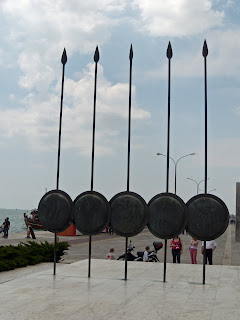King Philip, one year later (358 BC)
But, returning to 358 BC after one full year of kingship, Philip had to secure his border with the Paeonians again and trounced them. As a result, Paeonia became a sort of buffer zone between Macedonia and the tribes of the Danube to the north, which was the trade route up the Axios Valley and beyond. Philip’s army now numbered 10,000 infantry and 600 cavalry, no small achievement if you consider that only a year or two earlier, the Illyrians had defeated nearly the entire Macedonian army. He was confident about marching into Illyria and bluntly refused to accept old king Bardylis’ terms. Both armies met near today’s Lake Ochrid, maybe close to the town of Heraklea Lyncestis, and by the end of the day, the Macedonians had killed 7,000 Illyrian soldiers.
Philip seemed to have it all planned. He demanded that the Illyrians pull out of Upper Macedonia north to Lake Lychnitis, including the tribes of Orestis, which until now were controlled by the Molossian King of Epirus. This way, he had an open route into Epirus to the south and Orestis in the east. A surprising fact is that Parmenion, one of the Paeonian chieftains, was made a general soon after coming over to Philip’s side – an interesting background for this man who served both Philip and Alexander for many years. At this stage, Philip started training recruits from these newly conquered territories, the non-nobles as infantrymen and the nobles as cavalry. This practice stayed in place far into our 20th century!
This latest victory also meant that Macedonia virtually doubled in size, that the size of Philip’s army increased substantially in only one year, and that Upper and Lower Macedonia were united as never before. Philip, still married to the Illyrian princess Audata found it wise to change her name to Eurydice to mask her origin. Their daughter Cynane later married Amyntas, the original heir to the Macedonian throne.
Time now to switch attention to the southern borders with Thessaly and two of its cities in particular, Pherae, with its harbor Pagasae controlling the coastal states, and Larissa, which controlled the inland states. Strangely enough, both cities were bitter enemies. It so happened that Larissa turned to the king for an alliance against Pherae. Philip agreed, be it for his own reasons, i.e., to incorporate the expert Thessalian cavalry into his new army (estimated to be 3-6,000) and to consolidate Macedonia’s southern borders. This alliance was cemented by Philip’s (third) marriage to Philinna from Larissa. She was to bear him a son, Arrhidaeus, the following year.
 After these events in 358-357 BC, Philip planned to include Epirus to consolidate his borders. Three large tribes dominated that country, the Thesprotians, the Chaonians, and the Molossians, who spoke a kind of Greek dialect and were the most powerful and prosperous. Since Epirus had also suffered from the Illyrians, a treaty with Philip was relatively easy, and it was sealed by his marriage to Princess Olympias, Philip’s fourth wife. So in 357 BC, Philip’s borders were mainly secure, but there were still two significant enemies to deal with: Athens and the Chalcidian League, who, luckily, were not on friendly terms with each other!
After these events in 358-357 BC, Philip planned to include Epirus to consolidate his borders. Three large tribes dominated that country, the Thesprotians, the Chaonians, and the Molossians, who spoke a kind of Greek dialect and were the most powerful and prosperous. Since Epirus had also suffered from the Illyrians, a treaty with Philip was relatively easy, and it was sealed by his marriage to Princess Olympias, Philip’s fourth wife. So in 357 BC, Philip’s borders were mainly secure, but there were still two significant enemies to deal with: Athens and the Chalcidian League, who, luckily, were not on friendly terms with each other!
The Chalcidian League had a powerful army counting 10,000 infantrymen and nothing less than 1,000 cavalry. We should remember that the Chalcidice thanked its economic importance to the mines of the Crenides. The Athenians, meanwhile, had established settlements at Potidaea (on the neck of the Kassandra peninsula), close to Olynthus, and had captured Torone at the tip of the middle finger of the Chalcidice. And, of course, they still had an eye on Amphipolis, a most important crossing on the trading route with Thracia, including the rich mines of Crenides, the waterway to the Strymon River, and the Danube beyond. To send help to Amphipolis, Athens needed a nearby base for their fleet, and they eventually found one on the island of Thasos.
Philip’s attack on Amphipolis was quickly settled, and the city capitulated in the late summer of 357 BC. He also attacked Athens’ ally Pydna, which promptly fell to him. As a reminder, we should not forget that Philip was only 26 years old then.
Tensions between Philip and Athens ran high at this point, and both parties sought an alliance with Olynthus because of the forces it could muster. Olynthus apparently was blinded by Philip’s promises, and a treaty was made in the winter of 357-356 BC. Copies were set up in Delphi, at the Temple of Zeus in Olympia, in Dion, and at the Temple of Artemis in Olynthus. As a consequence, Philip besieged Potidea and occupied the city.
He had no time to take a break, for now, the king of eastern Thracia besieged the strategic and precious city of Crenides. It was only about 40 miles east of Amphipolis, just above the port of Neapolis (today’s Kavala), a valuable naval base in the region. Philip immediately marched in and defeated the Thracian forces despite their sudden coalition with Illyria and Paeonia. Philip was determined to stay and to put his stamp on this place, he changed its name to Philippi. He fortified the city walls and towers and increased the output of silver coinage. The marshy plain was drained and cultivated, meaning another boost for the local economy.








